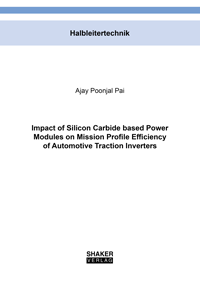
Shop : Details
Shop
Details
48,80 €ISBN 978-3-8440-7475-8Softcover168 pages50 figures248 g29,7 x 21 cmEnglishThesis
July 2020
Ajay Poonjal Pai
Impact of Silicon Carbide based Power Modules on Mission Profile Efficiency of Automotive Traction Inverters
This work investigates the efficiency benefits of replacing Si power modules of automotive traction inverter applications with SiC-based power modules, for mission profiles such as the WLTP, NEDC and Artemis, at different boundary conditions such as switching speed, operating voltage, current, switching frequency and coolant temperature. The compared power modules are in an identical package with state-of-the-art stray inductance optimized for fast switching, and only the chip technologies are varied. The rest of the system
is kept the same too. This gives a direct comparison of Si versus SiC without giving scope for any discrepancies arising due to differences in the package, e.g., module stray inductances, thermal stack, or due to differences in the system, e.g., electric motor characteristics and gate driver behaviour. A quadratic curve-fitting based behavioural power loss model is developed which is optimized for mission profile analysis. The power losses are modelled not only in terms of the operating currents, voltage and temperature, like most existing models in literature, but also in terms of gate resistance and gate driver voltage which have a major impact on the power losses. It also models in terms of chip area which makes it suitable for calculating the optimum chip area for a given application. The proposed power loss model is verified with two independent measurement methods, viz., calorimetric and power analyser based methods. It is shown that SiC devices can bring upto 80% reduction in the inverter average power losses, which could pave the way for more efficient traction
inverters.
Keywords: Silicon Carbide; SiC; Automotive Traction Inverters; Mission Profile Efficiency; Power Loss Calculation; Power Loss Measurement; Calorimetric Method; Power Module; IGBT; SiC Mosfet; SiC Diode; Infineon
Available online documents for this title
DOI 10.2370/9783844074758
You need Adobe Reader, to view these files. Here you will find a little help and information for downloading the PDF files.
Please note that the online documents cannot be printed or edited.
Please also see further information at: Help and Information.
Please also see further information at: Help and Information.
| Document |  | Document | ||
| Type |  | |||
| Costs |  | 36,60 € | ||
| Action |  | Purchase in obligation and download the file | ||
| Document |  | Table of contents | ||
| Type |  | |||
| Costs |  | free | ||
| Action |  | Download the file | ||
User settings for registered online customers (online documents)
You can change your address details here and access documents you have already ordered.
User
Not logged in
Export of bibliographic data
Shaker Verlag GmbH
Am Langen Graben 15a
52353 Düren
Germany
Am Langen Graben 15a
52353 Düren
Germany
Mon. - Thurs. 8:00 a.m. to 4:00 p.m.
Fri. 8:00 a.m. to 3:00 p.m.
Fri. 8:00 a.m. to 3:00 p.m.
Contact us. We will be happy to help you.



